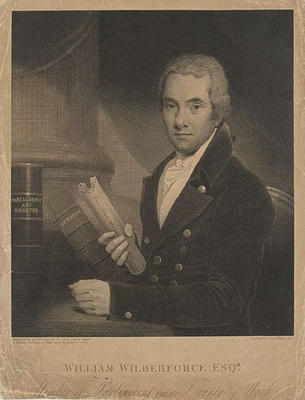Engraving
Maker & role
John Russell; R.A., Artist; James Heath (b.1757, d.1834), Engraver
Production date
circa 1807
See full details
Object detail
Title
William Wilberforce, Esq., Member of Parliament for the County of York.
Production place
Collection
Measurements
0 - Whole, H: 36.6 x W: 28cm (H: 366 x W: 280mm)
Production notes
After John Russell.
Subject person
Signature & marks
Printed beneath image "WILLIAM WILBERFORCE ESQR. / Member of Parliament for the County of York".
Printed text lower left; "Painted by the late John Russell Esq. R.A. Crayon Painter / to the King the Prince of Wales and the Duke of York".
Printed lower right; "Engraved by James Heath A.R.A".
Printed text lower left; "Painted by the late John Russell Esq. R.A. Crayon Painter / to the King the Prince of Wales and the Duke of York".
Printed lower right; "Engraved by James Heath A.R.A".
Credit line
Gift, through the Australian Government’s Cultural Gifts Program, 2004
Elizabeth Bay House Collection, Museums of History New South Wales
Elizabeth Bay House Collection, Museums of History New South Wales
Caption
William Wilberforce, Esq., Member of Parliament for the County of York (c1807)
Description
Engraved half length seated portrait, captioned ‘William Wilberforce, Esq., Member of Parliament for the County of York’. The work depicts Wilberforce with the ‘Slave Trade Abolition Bill’ in his hand. Bound copies of the ‘Parliamentary Register’ and ‘Debates’ [Hansard] appear to his right. A conventional large column is in the background to the right.
Closely connected with the government and social circle of William Pitt, William Wilberforce (1759-1833) was a key figure in the campaign to abolish slavery, and instrumental in the Slave Trade Act of 1807 and the Slavery Abolition Act of 1833.
The quantity and substance of information on illegal slaving activity in the Caribbean received by the British Parliament rose dramatically during the period that William Sharp Macleay (son of Alexander Macleay, builder of Elizabeth Bay House) was British commissioner to the Court of Havana, Cuba, for the Abolition of the Slave Trade (1852--30) and then a judge in Cuba (1830-36). Other colonial figures involved in the campaign included William and James Macarthur. The Macleay Women were interested in a range of Anglican Evangelical ventures.
Portraits of significant politicians, academics, historical and literary figures, churchmen and reformers, often published in folios were popular for libraries and dining and other rooms. The recreated collection of portraits at Elizabeth Bay House is based on the inventory of the pictures at Brownlow Hill, 1859, which is believed to include pictures sent from Elizabeth Bay House in 1845. The Brownlow Hill inventory includes a portrait of British Prime Minister, William Pitt, but not Wilberforce. Wilberforce was, however, closely connected with Pitt’s government and social circle.
Closely connected with the government and social circle of William Pitt, William Wilberforce (1759-1833) was a key figure in the campaign to abolish slavery, and instrumental in the Slave Trade Act of 1807 and the Slavery Abolition Act of 1833.
The quantity and substance of information on illegal slaving activity in the Caribbean received by the British Parliament rose dramatically during the period that William Sharp Macleay (son of Alexander Macleay, builder of Elizabeth Bay House) was British commissioner to the Court of Havana, Cuba, for the Abolition of the Slave Trade (1852--30) and then a judge in Cuba (1830-36). Other colonial figures involved in the campaign included William and James Macarthur. The Macleay Women were interested in a range of Anglican Evangelical ventures.
Portraits of significant politicians, academics, historical and literary figures, churchmen and reformers, often published in folios were popular for libraries and dining and other rooms. The recreated collection of portraits at Elizabeth Bay House is based on the inventory of the pictures at Brownlow Hill, 1859, which is believed to include pictures sent from Elizabeth Bay House in 1845. The Brownlow Hill inventory includes a portrait of British Prime Minister, William Pitt, but not Wilberforce. Wilberforce was, however, closely connected with Pitt’s government and social circle.
Accession number
EB2007/2



Public comments
Be the first to comment on this object record.